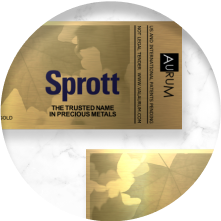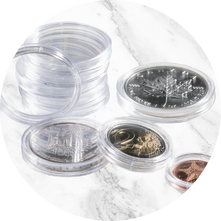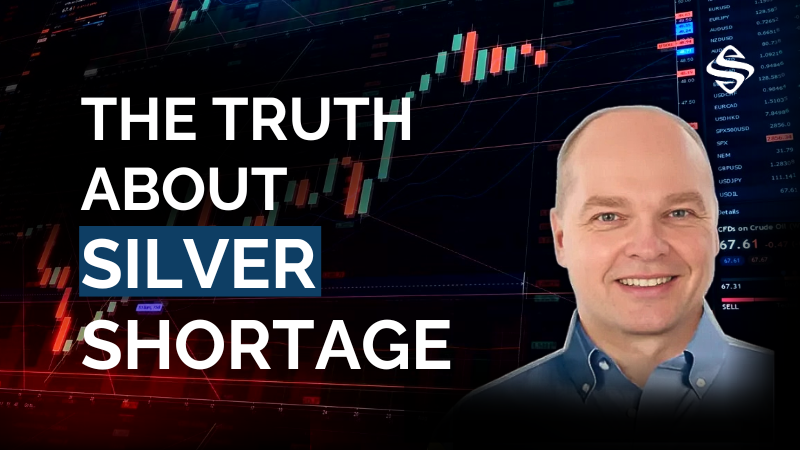Did you know you can get the Sprott Money Monthly Wrap-Ups, Ask The Expert,
special promotions and insightful blog posts sent right to your inbox?
Sign up to the Sprott Money Newsletter here.
London’s precious metals market is seeing massive outflows—10M oz of gold and 130M oz of silver have left vaults since December. What's driving this shift?
- Bank of England’s gold leasing: What’s the endgame?
- Silver lease rates hit 20%—a historic squeeze.
- COMEX sees record gold deliveries—why now?
- Is London’s gold supply sustainable?
Listen to David Jensen & Craig Hemke break it all down—tune in now!
Craig Hemke (00:00)
Hello again from SprottMoney and SprottMoney.com. We are now into the month of March, 2025, which means it's time for your Ask the Expert segment. I'm your host, Craig Hemke, and joining me this month is David Jensen. David, mining executive and market analyst, does great work keeping track of the physical markets, particularly as metal flows out of London. And it's just great to consider him a friend and great to have him on for this month's Ask the Expert. David, thank you for joining me.
David Jensen (00:47)
My pleasure, Craig. It's always good to talk with you.
Craig Hemke (00:51)
It's always good to get caught up with you too. And again, before we get started, just a reminder that all of this content comes to you courtesy of Sprott Money. And you want to make sure you thank them. Subscribe to whatever channel you're watching. hey, if you're in the market for physical metal, stop by SprottMoney.com. And this time of year, make sure you're funding your RRSP or IRA accounts with new cash and buy some physical metal, every ounce that you take.
and put in your IRA is segregated and allocated and that takes it out of the banker's hands and makes it that much more difficult for them to lever the markets up. So visit SprottMoney.com for more details. You can also just give them a call at 888-861-0775. So let's get back to David. David Jensen again, mining executive, market analyst. You can find his work on Substack where he's currently cranking out.
two or three things a week, encourage you to find him and subscribe. David, what's that sub stack address?
David Jensen (01:51)
Sure, it's jensendavid.substack.com.
Craig Hemke (02:00)
Even an old man like Craig can remember that one. That's nice and simple. Thank you for making it that way. You know, and here's the thing about David. That London physical market, as most investors know, is deliberately opaque. Okay, they try to not let you know what's really going on there. And so there's not a lot of analysts that understand it. And there's even a shorter list of analysts that can explain it. David is kind of that unicorn that he can do both. And that's what you'll find.
on his substack and that's what I hope to get into today. David, since late last year after the election of Trump, and I don't know if it's related to all this tariff prospects or whatever, but we've really seen some interesting tightness in the metal market. It began with a widening of the spreads in December between spot and futures. That then went away. Then here it came again in January and has persisted though it has narrowed a bit.
recently. We've seen reports of all sorts of metal moving around the planet, large deposits into COMEX vaults. It certainly seems to be an interesting time to monitoring the precious metals. So with that all in mind, let's just get your current thoughts on both. What are you seeing in gold and where do think this is heading?
Craig Hemke (03:22)
Okay, so the holdings to the end of February in London, in the London vaults, is showing it's down in the area of about 10 million ounces. But gold flows both ways, both in and out of London. And we've heard from Stonex, which is the big commodity trading house, they've got offices globally, and they said that from their estimates about 2,000 tons
of gold which is roughly 56 million ounces had flowed into the US from vaults globally and You know the BOE has said that about half the gold that has gone into the US has come From the UK from their vaults, so their vaults are down 10 million ounces, but of the order of probably 20 to 25 million ounces has come out of the vaults in London
So there's been flow in both directions, but I think that what has been primarily responsible for narrowing the gap there between the London price, the spot price and the near futures price in New York has been this leasing of gold. And leasing of gold is primarily coming from the Bank of England and they are holding roughly 130 million ounces of gold.
a small amount for themselves and then holding gold for other central banks. And this is kind of a fudge factor if you want to call that. They actually, know, leasing gold doesn't really solve a gold shortage problem. It smooths it out to the future because you're taking somebody else's gold and lending it to somebody that needs gold. But then that person has to go out and source the gold in the market.
Craig Hemke (04:57)
Yeah. Yeah.
David Jensen (05:16)
We've got this, you know, central bank fudge factor that's been applied to the market that has reduced the shortage of gold in the market, but it still has to be made up. And so, you know, it's not just the gold market, which is showing shortage, but it's also the silver market. And the silver market is not showing these same types of lowering of stress or the same order of lowering of stress that we've seen in gold.
And I would put that down to the fact that the central banks, the Bank of England, do not have silver in hand to smooth the market, to play games with the market. And that's the crucial thing. And as you know, Craig, the London market, the spot market there, which is immediate ownership, you have these promissory notes that they trade there and you're supposed to get metal immediately. I mean, the open interest is estimated to be between 400 million ounces for gold.
and five billion ounces for silver. It's crazy, for silver it's six, seven times annual mine production of these contracts that are standing there as promissory notes that you're supposed to theoretically be able to get metal for and we know that the numbers just don't work out and it's not possible.
Craig Hemke (06:37)
Have you seen David an update on delivery delays in London? know, there was that article in the Venerable Financial Times, well, over a month ago that said, you know, if you're queuing up for gold in London, it's four to eight weeks. I've not seen an update. Have you heard anything?
David Jensen (06:45)
Yeah. Yeah.
I have not recently, but I think that the swing in the spread between London and New York tells us that is reducing somewhat. But again, it's being reduced because of metal that's owned by central banks is being pushed into the market on a temporary lend basis. And it does nothing fundamentally to deal with the underlying organic shortage of metal that's in the market.
gotta be returned.
Craig Hemke (07:25)
Exactly. And to that same end, you talk about what a levered fractional reserve market London is. Well, COMEX was never designed as a physical market. The offtake there has always been 1 % of the open interest. But February, the first delivery month of the year on COMEX, saw a record, all-time record, something like 77,000 contracts delivered.
Okay, if there's tightness in London, why is there suddenly all of this demand out of New York, do you think?
David Jensen (08:02)
Assets are being moved into repositories of wealth that are nobody else's liability. I think that's as accurate as we can be. There's clearly a market sea change and there's a decision made to secure these assets, to secure wealth in assets which are not connected to the financial markets.
I think that's as accurate as we can be on that. And I've noticed here in this past week that the banks have distinctly done unwell in terms of their stock prices. And as we know, there's a lot of losses in the banking system, which is not mark to market. you know, the BKX, the banking index is down from 140 to about 117 here over the last
Craig Hemke (08:52)
Correct.
David Jensen (08:59)
six weeks. and JP Morgan has suffered badly this week which has been really interesting because they were supposed to what were they saying they had a fortress battle sheet as a sorry a a fortress balance sheet pardon me so I don't know there's something something appears to be cooking in the financial system and there is a widespread moved into secure the secure assets of which gold and silver I think are the premier ones.
Craig Hemke (09:29)
Yeah. Well, all right. That is a good segue. The stress that is building in this system is what you've been writing about and what we've all been noticing and trying to connect the dots. And ever since the dissolution of the London Gold Pool in 1968, we haven't been pricing things in a real manner, in a fair value. We've been using these digital derivatives in this fractional reserve system.
applying great leverage, know, and developing products. Yeah, this is just as good as gold. This is gold price exposure, that sort of thing. I want to read some
David Jensen (10:04)
Right. Right. it wasn't
even that Craig so much or in addition to that, I should say, I mean, the Bank of England created the LBMA, which endorsed the trading of these fractional reserve gold and silver notes in 1987. And essentially what they did was they converted gold and silver from real assets into virtual assets. And they couldn't even tolerate with their fiat money games.
Craig Hemke (10:28)
Mm-hmm.
David Jensen (10:33)
and system, couldn't even tolerate the signals that gold and silver were sending. Not only did take gold and silver out the financial system, but they couldn't have any commentary from the sidelines. And they basically shut it down, shut down the price signal then in 1987.
Craig Hemke (10:48)
40 years ago. How long this has been building. I want to read everybody the conclusion of your most recent post, which I think you published on maybe Wednesday the 12th or Tuesday the 11th. Markets seldom resolve themselves in a day. However, there is a breaking point when the fetid wall of London detritus is going to wash throughout the city of London, terminating the promissory note market.
that has been used by the Bank of England and select bullion banks for decades to price fix silver and gold to the detriment of humanity. I like that.
David Jensen (11:27)
Unfortunately, I think it's unavoidable at this point.
Craig Hemke (11:33)
Well, now, and again, a lot of folks, since I've been focused on this for 15 years now, and the talk even way back then was, you know, silver is the Achilles heel. And as you mentioned, I mean, papered over, pun intended, I guess, maybe some of the issues in gold that appeared in January and February through leasing, but nobody has any silver to lease.
So could you walk us through a little bit what you're currently seeing in silver and could that in the end still be that silver bullet?
David Jensen (11:59)
Exactly.
Yeah, okay. So, I mean, the silver market in London in the vault holdings.
You know, they're holding of the order of a little over 800 million ounces of silver in the London vaults. And we've seen a draw down here of about 130 million ounces that have been drawn down since the beginning of December. And so theoretically, theoretically in London, there's what is it about 700, 722 million ounces.
in the market there. But 524 million ounces there that are held in the market in the London Vaults are held by ETFs. So that gives us a theoretical, let's call it a theoretical float of 198 million ounces or call it 200 million ounces that's left.
Craig Hemke (13:08)
David, if I might interrupt you, I mean, is that within the prospectus? Have you ever read the SLV or anything? Is it legal? I guess is the right term for them to lease or loan the bar?
David Jensen (13:21)
Well, they don't
admit to any of that. They don't admit to any of that, which is why we deduct the 524 million ounces. So, yeah, so they have, you know, I argue that they may well have been leasing. It appears that they've been leasing and that was, well, there was indications from Jeff Curry from Goldman Sachs there in 2021 that they were creating claims and shorting the silver that was owned by shareholders into the market. so of the 200 million ounces left,
Craig Hemke (13:26)
Right, okay, right, okay.
was amazing.
David Jensen (13:51)
In London vaults, I mean, this is just privately owned silver. And what we're seeing now is a couple of things like every day in the COMEX over the last four days, it's been between three and five million ounces of silver futures contracts that have been traded as exchange for physical. So that allows an immediate claim and delivery in the London market. So, you know, we're seeing this
Continual drip drip three three to five million ounces and that adds up to a substantial amount of silver over time Which is being pulled on the market? but I think that the key thing that we're seeing as well at the same time is the fact that the implied lease rate which is which is Calculated from the spot price versus the forwards in London
Craig Hemke (14:44)
Mm-hmm.
David Jensen (14:44)
is showing that it's moved up into the 10 % range here yesterday. And we've seen from the gold market here in December and January that the actual lease rate was roughly twice the advertised implied lease rate that we were seeing published by Bloomberg. So the implication is here that we've got a 20 %
per annum lease rate on silver, is unheard of because it's normally zero or even negative given the cost of storage and ensuring and how bulky silver is. it appears that there, know, silver does move both ways in and out of the London vaults, but it appears that the flow is increasingly one way, which is out and that this material is moving into the global market. Most of it, the preponderance I suspect is into the U.S.
But we can't see all the private vaults. can see the COMEX vaults, but we can't see all the private vaults in the US. So it'd be very interesting to follow the trade statistics coming out of America here over the next few months. But the indication here, Craig, is that theoretically there's a float of 200 million ounces in London. as I posited to you last time,
There may only be a few million to a few tens of millions of ounces of silver truly available to market in London against these five billion ounces of spot claims for immediate ownership. So I think that's the hard part we're getting to. The drawdown that we've seen here, about 120, 130 million ounces in the last three months from London Vaults, it's been a company with almost no change in the trading volume, in the daily trading volume.
So I'm taking from that that there's not been a market phase change where there's been a stepping into the London market in terms of increased speculation, increased interest and a securing of these contracts. And it may just be that existent holders of the metal were just like, we're not happy and comfortable with the UK, with what Starmer is doing and we think there's a better, more secure place to be holding our.
Craig Hemke (16:57)
Mm-hmm.
David Jensen (17:02)
our most important assets which are gold and silver.
Craig Hemke (17:06)
Regarding those numbers you've been put, you mentioned, hey, I just encourage everybody to go to David's Substack, that jensendavid.substack.com, article that you wrote, posted Tuesday the 11th called Market Data Indicate Approaching London Silver Price Fixing Implosion as Silver Vacuum Intensifies. That's where you'll find where David has these numbers. So you know where, if you want to read more about this, that's where you want to go. Find that link.
You know, you talk about just the sheer size of these numbers, David. What was the number you said that you had seen or that London admitted to coming out of London, 130 million ounces or something like that? Okay, well maybe Sprott Money will add this latest table that I'm looking at on my computer right now. The CME puts out Vault stock data every afternoon. Now, the CME...
David Jensen (18:01)
Mm-hmm. Mm-hmm.
Craig Hemke (18:05)
Just understand at the bottom of every single one of these reports, they place a disclaimer that says the information in this report is taken from sources believed to be reliable. However, the CME disclaims all liability whatsoever with regard to accuracy or completeness. Okay, thanks. How I with that as a back background for the report for Monday that was released on Tuesday, the 11th. So this is just one day. The CME and their
nine volts around the tri-state area reported 3.483 million ounces of silver going into five volts. Asahi Brinks, HSBC, JP Morgan and Malca. Just those five volts received 3.48 million. Wait a second, how much is that? That's 108 metric tons, David! We're alleged!
David Jensen (19:05)
Right?
Craig Hemke (19:05)
to have come from somewhere? I mean, this is not internally just shifting it around. This is new silver coming into the... Where the hell are they getting this silver, David?
David Jensen (19:15)
I think from all sources, it's not just London, but clearly there is a move to secure these two critical assets in the U.S. I think, you know, going back to London again, like I believe that what the point that we're at now, Craig, is that the flow appears to be increasingly in one direction. And if there is this daily EFP draw, exchange for physical draw of the order of, say,
Craig Hemke (19:38)
Mm-hmm.
David Jensen (19:44)
give it an average number of 4 million ounces, it doesn't take very many trading days to be able to draw down very, very serious levels of silver out of the London free float, which is what's really available to market. So we may be looking at 10, 20, 30 million ounces available to market and that they're gnawing into this now with these EFP contracts and with simple securing of
of the spot contracts in the London market and saying thank you for the promissory note, we'll take the medal now. This is not something which is, yeah, the spread difference has changed between London, New York and the gold market, but we're seeing with these spiking lease rates in London that we're on the verge of something in the silver market, which appears to be breaking into a new realm here. A 20 % lease rate is astronomical.
And was just yesterday, so let's see what it is today and tomorrow and the day after.
Craig Hemke (20:48)
And I guess we'll just kind of wrap up with this. mean, you and I have discussed this for as long as we've known each other. I've been talking about this on my site for 15 years. This is why you gotta own your own physical metal. I mean, you just, cannot work with just simply, hey, I've got price exposure, I own the SLV. This is scandalous. You're reminding me of this, David, from four years ago with that silver squeeze. Jeff Curry was the head of commodity trading for Goldman Sachs, so he should know. And he said the fire got put out.
by the ETF's loan. Wait a second. The shareholders of the SLV want the price appreciation. They don't want you hedging that. What is going on there? It's scandalous. And so you can't.
David Jensen (21:31)
It's insane.
Given this is a sprot show, Craig, what is interesting is that this PSLV truck
Craig Hemke (21:39)
Correct. Well,
let's differentiate. That's a Sprott Inc.
David Jensen (21:43)
Right. And the metal secured
that the Canadian Mint, but I think the key to this fund is the ability to secure 10,000 ounces at a time in baskets and get delivery. you know, the daily trading volume has gone from of the order of about 5 million ounces a day last summer, or sorry, 5 million shares a day last summer. And it's going to like 10X that now. It's like between 50 and 60 million shares a day.
Craig Hemke (21:53)
Yes.
the P that we're talking
about the PSLV, Sprott Inc. managed PSLV, physical silver that you can actually read, know, the SLV can only get redeemed in silver taken out by the bullion banks, the authorized participants, but the PSLV could be anyone. You mentioned, back up a little bit David too, on the PSLV, the trading volume, but also have you seen the short volume, which is 10, what 20 times what it was when the year began.
David Jensen (22:24)
Right.
Craig Hemke (22:41)
What is that telling you?
David Jensen (22:43)
It looks to me like price containment.
Craig Hemke (22:47)
Okay. And well, it could also be, you you have to borrow shares at the market to get a bundle together to redeem. And again, you got to redeem at least got to have at least 10,000 ounces that you can take out of there at a time. And we're talking obviously.
David Jensen (22:48)
So you're.
Yeah. But I mean,
the stock is liquid enough, you could just step into it. If it's trading, you know, 50, 60 million shares a day, you're not going to move the market by stepping in and buying shares and taking delivery. So anyways, we'll see with time, but the trading volumes, it's exponentially moving up. But I think at some point we're going to see the price of this PSLV
Craig Hemke (23:15)
Mm-hmm.
David Jensen (23:28)
break away from the COMEX and the London price because people know that they can actually get metal through this. And I am watching it every day to see, you know, the last time I checked the NAV, the net asset value on that, it was negative, but only by a small amount. It had tightened up quite a bit. But I'm expecting the price of the stock versus the NAV to turn positive and for it to break out because I think that's the last...
source of metal for those who are truly desperate for the metal to get the metal and take delivery.
Craig Hemke (24:02)
Goodness gracious. Well, you're doing a great job monitoring that on that sub stack. Let's just, let me just ask you one last question. As it pertains to silver. And then maybe it's just a combination of everything, but that's hard for the regular person to do. But what factor do you watch the most? Is it the cost to borrow shares of the SLB? Is it the once monthly reports that come out of the LBMA? Is it the volume trading in PSLB? Is it the volume of metal allegedly flowing into the COMEX? Which one would you,
be the number one thing people should monitor, you think?
David Jensen (24:34)
I'm following two things. One is the calculated lease rate in London though, not in New York, like not in the COMEX. they're looking at spot versus London forwards. the source on that that I found recently is this, is it Steven Gottlieb? So he's a long-term
Craig Hemke (24:45)
Okay.
Yep.
David Jensen (25:04)
participant in the markets. And the other thing I'm following, and I've gotten in touch with a couple of bullion banks in London, is the price backwardation. So the tendency for the price in the spot market to move above the forward price, the futures price in New York or the forward in London. So once you start getting the physical price rising above it, normally that's in what they call a contango, where it's below the forward price.
And we've seen this tendency to move into back-redation in London. And so I'd say those are the two physical, they've tried to take away all the physical indicators that we can use in terms of determining what true supply and demand is. The LBMA until 2015 used to publish the lease rate. And now good luck finding the lease rate. Even the lease rate published by TD is not the actual lease rate.
Craig Hemke (25:57)
Right. Right.
David Jensen (26:02)
They publish in their documents, they're publishing an estimated lease rate, an implied lease rate in the market using Spot and Futures. So I'm using this Gottlieb source there in LinkedIn and then we have to apply some factor to it because it's an implied lease rate from London and as I mentioned earlier we've seen a true lease rate that's almost double that.
So, you know, the fact that we've seen a 9-10 % lease rate in London in the implied level with the potential that it really means it's approaching 20 % in the true market rate, means that I think we're very, very close to something snapping, And it does, things do snap when you leave them, when you create market instabilities for four decades, they will snap in the end.
Craig Hemke (26:58)
Yeah, right, a lot of catching up to do. David, we've done a lot of catching up and I very much appreciate it. Again, I wanna encourage everybody to follow David on Substack so you can stay up to date on his thoughts. David, thank you so much for your time. It's just been incredibly valuable to visit with you and hopefully we can do it again soon.
David Jensen (27:00)
Yeah.
Indeed. Thank you for your time, Craig. And always good talking.
Craig Hemke (27:22)
And from all of us at Sprott Money, SprottMoney.com. Hey, be sure to like or subscribe to the Sprott Money channel on your way out so you don't miss any more content. We got a lot more coming here in March and as we go through the year. But thank you for watching and we'll have more interesting info as March continues and what is developing is a crazy 2025.
Don’t miss a golden opportunity.
Now that you’ve gained a deeper understanding about gold, it’s time to browse our selection of gold bars, coins, or exclusive Sprott Gold wafers.
About Sprott Money
Specializing in the sale of bullion, bullion storage and precious metals registered investments, there’s a reason Sprott Money is called “The Most Trusted Name in Precious Metals”.
Since 2008, our customers have trusted us to provide guidance, education, and superior customer service as we help build their holdings in precious metals—no matter the size of the portfolio. Chairman, Eric Sprott, and President, Larisa Sprott, are proud to head up one of the most well-known and reputable precious metal firms in North America. Learn more about Sprott Money.
Learn More
You Might Also Like:


















Looks like there are no comments yet.